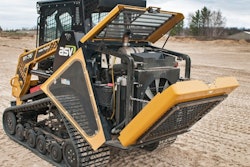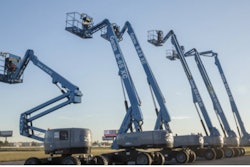Chevy adds new 2.7L Turbo I4 to 2019 Silverado 1500’s expanded powertrain options
The 2019 Chevy Silverado 1500 is set to offer more engine and transmission combinations including an all-new four-cylinder turbo 2.7-liter engine.
The 310-hp 2.7-liter I4 replaces the 4.3-liter V6 as the standard engine on the high-volume Silverado LT and new Silverado RST and is expected to offer a 22-percent increase in torque at 348 lb-ft, better fuel efficiency and a stronger power-to-weight ratio than current models.
Chevy calls the new I4 a “clean-sheet design” developed specifically for truck applications and delivering peak torque from 1,500 to 4,000 rpm. Chevy expects the 2.7L engine to be very competitive with V6 engines on rival trucks. The automaker says the turbo I4 is expected to deliver “comparable” payload capacity with greater torque than the 3L V6 on the Ford F-150 XLT and the 3.6L in the Ram 1500 Big Horn.
To read more, click here.
How Volvo is building a loader that works a quarter-mile beneath the operator’s feet
Volvo Construction Equipment partnered with Swedish mining company Boliden to field test remote control of a wheel loader located more than 1,312 feet underground.
Operated by a crew member positioned in an above-ground office at Boliden’s Kankberg underground mine, the wheel loader performed loading tasks in a production atmosphere while researchers examined remote-control-to-machine communication concerns such as network delays.
Safety was Boliden’s primary driver in participating in the research, says Fredrik Kauma, Boliden project manager. “The best way to avoid accidents is to take the operator away from a dangerous situation,” Kauma says. “We believe remote control is a critical component of removing the human element from the production face.”
To read more, click here.
OSHA removes crane capacity restrictions from operator certifications; will require more rigorous employer evaluations
After hearing extensive feedback from the construction industry that rated operating capacity (ROC) is not a suitable indicator of a crane operator’s skill and experience, the Occupational Safety and Health Administration announced today in a proposed rule change that it intends to remove an existing provision from its standard for cranes and derricks in construction that required different levels of operator certification based on a crane’s ROC.
Crane operators will still have to be certified, but, according to the new rule, they won’t be limited to what cranes they can operate by what cranes they have been certified on. From now on, that will all be in the hands of their employers.
With the removal of ROC-based restrictions from its required operator certifications, OSHA says it will instead require employers to thoroughly and continuously ensure the competency of their crane operators through training and evaluation. To that end, the agency will clarify its expectations of employers in regard to these requirements and it will establish minimum requirements for determining operator competency.
To read more, click here.
Deere-Hitachi unveil 345G LC, ZX345USLC-6 reduced tail swing excavators as partnership celebrates 30th anniversary
In what is perhaps the longest and most successful joint ventures in the heavy equipment business, John Deere and Hitachi are celebrating their 30 anniversary this year. To highlight the event the Deere brought the press to its Greensboro, North Carolina headquarters and showed us its latest excavator models and technology.
The newest machine produced by the joint venture is the Deere 345G LC. The counterweight on this reduced tail swing model barely inches out over the tracks when the cab is rotated 90-degrees, giving you a powerful digger (249-horsepower) that can be used where room to maneuver is at a premium, such as road building jobs, urban sites and landscaping.
The Hitachi version of the Deere 345G LC is the ZX345USLC-6.
To read more, click here.
Volvo, Skanska to test electric, autonomous site quarry for 10 weeks this fall (VIDEO)
Volvo Construction Equipment, which had announced its electric site quarry initiative at its Xploration Forum in September 2016, is now gearing up for a 10-week field test this fall.
The company says its building a fleet of eight prototype HX2 autonomous electric carriers to take part in the test, which will also include its LX1 hybrid wheel loader and an EX1 cable-connected excavator.
Volvo is partnering with Swedish construction giant Skanska Sweden, the Swedish Energy Agency and two Swedish universities on a $30 million project aimed at creating an electrified quarry where not only carbon emissions are reduced by up to 95 percent, but also the total cost of quarry operating costs are reduced by 25 percent.
The electric site project has developed into a rethinking of quarry processes and layout, particularly in the ways aggregate is handled. Instead of using articulated dump trucks or rigid frame haulers to move aggregate from Point A to Point B, the electric site concept will use the autonomous 15-ton HX2 carriers to load crushed aggregate directly from the crusher.
To read more, click here.














